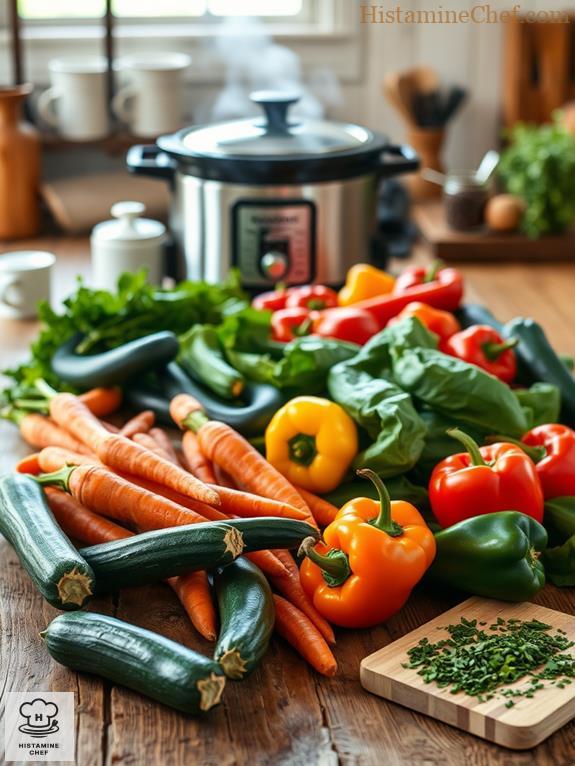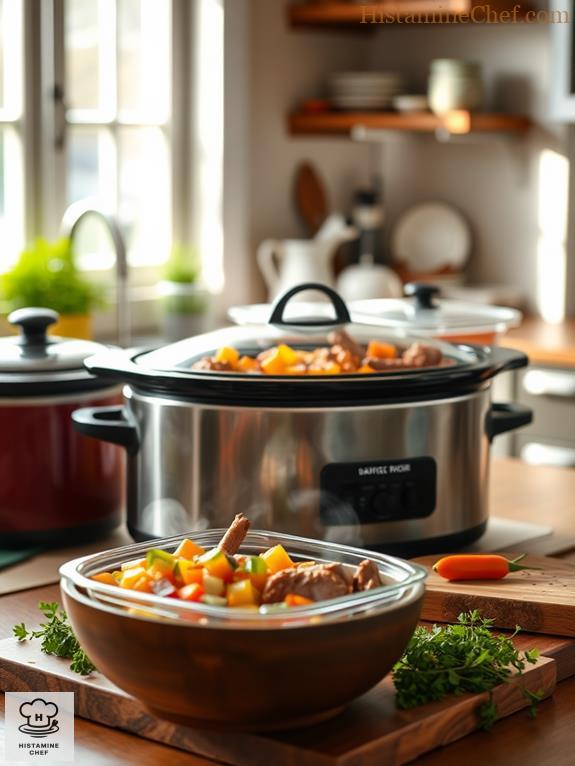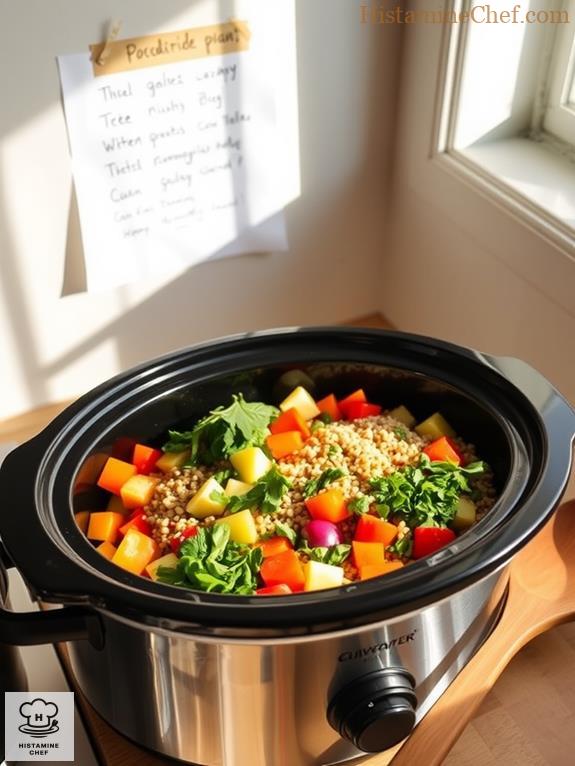Ever felt like your slow cooker was secretly plotting against your histamine-sensitive gut? I sure did!
I discovered the art of low-histamine slow cooking after a series of frustrating flare-ups. Now, I'm all about that SIGHI list life. Quinoa, zucchini, apples? In they go!
But watch out for those sneaky histamine villains like tomatoes and bananas. They're not invited to this flavor party.
Layer it up, set it, and forget it. The aroma? Pure bliss. My go-to? A veggie stew that'll make your taste buds do a happy dance.
Ready to revolutionize your cooking game? Let's dive in!
My Slow Cooker Salvation: A Histamine-Friendly Journey
Remember that time I thought I'd mastered low-histamine cooking, only to be betrayed by a seemingly innocent tomato sauce? Oof. That sent me spiraling into a week of discomfort.
But it also sparked my slow cooker epiphany. I experimented with herbs, played with cooking times, and even got my skeptical partner on board.
Now, our Sunday prep sessions are a thing of legend. From bone broth to herb-infused chicken, we're living that low-histamine, high-flavor life.
And the best part? No more mystery ingredients or dining-out anxiety.
Key Takeaways
- Verify all ingredients against the SIGHI list to ensure they are low in histamines before meal prep.
- Utilize low-histamine vegetables like zucchini and carrots for flavorful, nutrient-rich slow-cooked dishes.
- Experiment with ingredient substitutions to keep meals diverse and pleasurable within histamine restrictions.
- Layer ingredients in the slow cooker for even cooking and enhanced flavor profiles in your meals.
- Prepare multiple low-histamine meals simultaneously to save time and simplify your cooking routine.
Understanding Histamine Sensitivity

What does it mean to have histamine sensitivity?
It's like your body throws a party, but histamine decides to crash it! You might feel bloated, itchy, or even a bit dizzy after eating certain foods. These histamine reactions can be a real bummer, right?
Food labels can be tricky to navigate, but understanding them is vital for managing histamine sensitivity. Learning to spot hidden histamines in ingredient lists is an essential skill.
To manage this, dietary adjustments are key. You'll want to embrace foods that are low on the SIGHI list, like apples and quinoa, while dodging the high-histamine culprits like tomatoes and bananas.
Getting creative in the kitchen is essential! Think of it as a culinary adventure.
I started this blog, Histamine Chef, to share my journey and help others find delicious yet safe meals.
Benefits of Slow-Cooking

Slow-cooking offers several advantages, especially for those managing histamine sensitivity.
Batch cooking techniques can be easily adapted for slow cookers, allowing you to prepare multiple low-histamine meals at once. This approach is particularly helpful for those with histamine intolerance, as it minimizes food preparation time and reduces exposure to potential triggers.
I can't tell you how much I love the health benefits! Cooking at low temperatures helps retain nutrients, making my meals not just delicious but also packed with goodness.
And let's be real, who doesn't love the smell of a hearty stew wafting through the house?
Time efficiency is another huge perk. I can toss in my low histamine ingredients—like chicken and sweet potatoes—set the timer, and go about my day.
It's like having a personal chef, minus the apron!
Low Histamine Ingredients

When it comes to cooking for histamine sensitivity, choosing the right ingredients is essential for creating safe and satisfying meals.
I've discovered a treasure trove of low histamine vegetables—think zucchini, carrots, and bell peppers—that add color and crunch to my dishes.
And let's not forget about allowed fruits like apples and blueberries, which can brighten up any slow-cooked masterpiece!
For those missing tomato-based sauces, there are delicious alternatives that can provide similar flavors without triggering histamine reactions.
Imagine a fragrant stew simmering away, packed with these vibrant ingredients. It's like a warm hug for your tummy!
Always consult the SIGHI list to navigate your options. I find it helpful, and it keeps my meals stress-free.
Slow-Cooker Meal Prep Tips

Preparing meals in a slow cooker can be a game-changer for anyone managing histamine sensitivity. I love using clever slow cooker techniques that make meal prep a breeze!
First, always check the SIGHI list to verify your ingredients are low histamine. For instance, instead of tomatoes, try juicy, sweet peaches in your stew. Who knew, right?
Experimenting with ingredient substitutions not only keeps meals interesting but also avoids histamine triggers.
Smart cooking techniques can help you adapt your favorite recipes for a low-histamine diet, confirming you don't miss out on delicious meals.
And don't forget to layer your ingredients! Start with the denser items like potatoes, then add your protein, and finish with softer veggies. This way, everything cooks evenly.
Have you ever walked into your kitchen and been greeted by the aroma of slow-cooked goodness? It's pure magic!
That's why I write this blog—to share that magic with you!
Recipes for Histamine Sensitivity

Finding delicious recipes that accommodate histamine sensitivity can feel like a challenge, but it doesn't have to be!
One of my favorites is a hearty vegetable stew. Just toss in allowed veggies like carrots and zucchini with some fresh herbs for flavor.
For low histamine paleo options, consider using a crockpot to slowly cook your meals, which can help reduce histamine formation.
Or how about soup recipes? A creamy carrot soup made with coconut milk is both comforting and inventive!
Grain bowls are another winner—try quinoa topped with roasted sweet potatoes and a drizzle of olive oil.
For dessert, whip up some fruit compotes using apples and blueberries, sweetened with honey.
With these protein options and seasoning alternatives, you'll never feel deprived!
Recall, cooking can be fun, even with histamine sensitivity. Why not give it a whirl?
FAQ
Can I Use Frozen Vegetables in Slow-Cooker Recipes?
Absolutely, I love using frozen vegetables in my slow cooker! They're convenient for storage, and the slow cooker benefits include enhancing flavors while saving time. It's a perfect way to enjoy nutritious meals effortlessly!
How Do I Store Leftovers Safely for Histamine Sensitivity?
When I store leftovers, I use airtight containers to maintain freshness. For safe reheating, I guarantee food reaches a minimum temperature of 165°F. This method innovatively preserves flavor while minimizing histamine concerns.
Are There Any Histamine-Free Meal Prep Containers?
They say, "Good things come in small packages." I've found that using histamine-free materials for my meal prep containers guarantees durability and safety, helping me innovate my meal storage without worry.
What Are Common Symptoms of Histamine Sensitivity?
When I experience histamine intolerance symptoms, I often notice headaches, digestive issues, and skin reactions. It's essential to identify histamine sensitivity triggers, like certain foods, to manage these uncomfortable experiences effectively and innovatively.
Can I Adapt Traditional Recipes for Low-Histamine Cooking?
Adapting traditional recipes for low-histamine cooking's like transforming a classic painting—think outside the palette! I've found that creative low histamine swaps can breathe new life into old favorites, making them both innovative and safe.
Summary
I've mastered slow-cooker meal prep for my histamine sensitivity. By planning and experimenting, I create nourishing dishes that keep histamines in check. My kitchen now fills with enticing aromas as I confidently prepare meals tailored to my needs.
What's your experience with slow-cooker meal prep for histamine sensitivity? Share your insights and favorite recipes in the comments below.
Help spread awareness about histamine-friendly cooking. Share this post on your social media to support Histamine Chef and reach others who might benefit from these tips.


Leave a Reply to Barbara Saul Cancel reply